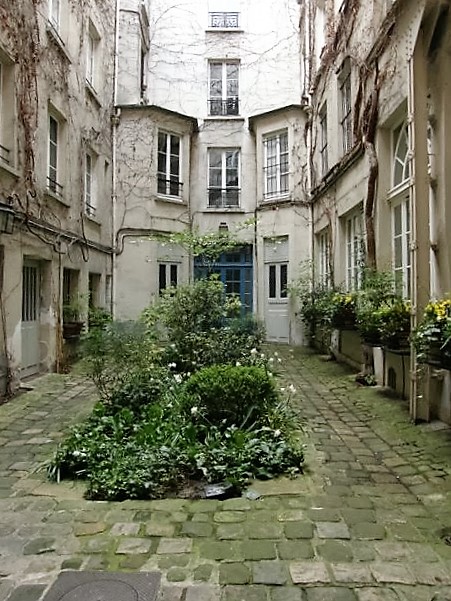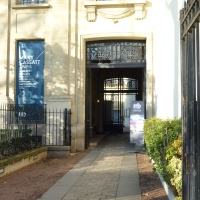On the morning of April 12, 2016, three of us set out from this courtyard on an astounding walk through the Marais. But the story starts much earlier.
In 1980, a sharp-eyed passerby spotted some photographs in a Paris dumpster and scooped them up. He or she took them to a knowledgeable collector. One can imagine the collector’s jaw dropping at the sight. Dozens and dozens of black-and-white images of Paris, taken in the early 1940s – that is, during the German occupation of the city.
In 2005, the collector showed them to Patrice Roy, architect and graphic artist, who selected about a hundred, 58 of which had been taken in the third and fourth arrondissements, the Marais. Roy lived in the Marais, and recognized many of the buildings. He researched the images, and discovered that the photos had been commissioned by the city administration to document îlots insalubres – “slum blocks” slated for clearance and redevelopment.
The images were the work of two commercial photographers – A. Cayeux and F. Nobécourt. Little is known about them, but they were following in the tradition of earlier photographers such as Eugene Atget and Charles Marville, who captured parts of the city that were destined to vanish.
Things turned out differently in this case.
At the time they were photographed, the Marais buildings were dilapidated. Former mansions of the nobility had become cheap lodgings and workshops for artisans and immigrants. The administration condemned the buildings and attempted to evict the tenants. Many did leave, but housing was scarce, and the city did not have the resources to tear down existing buildings and build new ones. So life went on in these old buildings.
As Patrice Roy looked at the haunting photos from the 1940s, he spoke of “testimony to a stoic melancholy” and buildings that looked “unreal, deserted, as if swept of inhabitants by the war.”* They had indeed been very dark times.
Attitudes changed after the war. In the early 1960s, the Minister of Cultural Affairs, André Malraux, mused on how “Paris noir était une ville triste” (the blackened Paris was a sad city). But the solution was not to demolish sorry-looking remnants of the past; rather, they could be saved as a fertile resource for city dwellers of the present. In his vision, “l’avenir ne s’oppose pas au passé, il le ressuscite” (the future does not oppose the past, it resuscitates it). This spirit and vision led to the Malraux law of 1962 that rescued so many old buildings from oblivion.
In 2015, Patrice Roy published the 58 photographs of the Marais from the 1940s with detailed descriptions of each image, as well as background information about the city’s plans for the area and the eventual fate of the buildings. The descriptions are thoughtful and reflective, making the reader slow down and gaze into the photographs. The result is Paris Marais 43: Arrondissements 4 & 3 photographiés durant l’Occupation par Cayeux et Nobécourt (Creaphis Editions).
We met Patrice in April of this year; he inscribed our copy of the book. When we told him we planned to search out some of the buildings in the photographs, he offered to give us a tour. We were delighted and honoured.
Patrice created a map for our walk. We more or less followed the route shown, with some detours. But it gives you a sense of the quartier we explored together, and some of the buildings we saw.
Our first destination was the Marché des Enfants Rouges. The market dates to the 1600s and is the oldest covered market in Paris. The name, which means Market of the Red Children, refers to the children from a nearby orphanage who wore red uniforms.
As we walked, we were astounded by Patrice’s intimate knowledge of the area. He had helped restore many of the buildings we saw and had anecdotes galore about such things as the sub-basement where crayfish were raised in tanks for a restaurant, or about disagreements within a dysfunctional committee of co-propriétaires that had led to blows. He led us through narrow lanes (ruelles) straight out of the Middle Ages and into hidden (but public) gardens along the way.
A few minutes into our tour, Patrice led us along a narrow laneway (ruelle) where numerous chasses roues stood as mute evidence of the days when delivery carts bumped along its length. The trickle of water down the sunken centre had been an open drain; we didn’t even try to imagine how it must once have smelled.
Today, most visitors, and perhaps Parisians, see the Marais as a destination of boutiques, galleries, restaurants and watering holes. However, as Patrice pointed to signs and opened doors, we could see many other types of businesses. But nothing we glimpsed prepared us for the wonders behind this sign.
Inside, people were packing and filling orders, but all was quiet. As our eyes adjusted to the subdued light, shiny objects demanded our attention.
Alas, we left without souvenirs: the shop full of stamped metal decorations carried out wholesale transactions in bulk only.
Another courtyard allowed Patrice to help us read more into what we saw. Why was one stone so much larger that the other cobblestones? It was a special workplace, he explained. Here a heavy section of a tree trunk would serve as the base for splitting firewood.
It reminded Norman of the section of tree trunk he uses to split wood for our fireplace in Toronto.
We have often seen pulleys suspended a storey or two above ground level to hoist goods up to a window or door. But we had never noticed anything like the curved metal wall hook to which Patrice drew our attention.
Getting wine barrels into the cellar safely would be a tricky job. If one raised the red door, one end of a rope could hold a barrel fast; the other end would go through the hook. The wine could be lowered safely by easing up on the rope, as one would do more elaborately with a capstan.
In the same courtyard it looked as if a basement window was missing. Not so. The unobstructed opening is an important part of a centuries-old ventilation system. Such openings allowed a free flow of air into and through the cellars.
When closed up, the air in the cellar often becomes musty and unpleasant. (On another walk, our friend Mireille had pointed out blocked-up ventilation spaces at ground level and speculated on the problems they caused.)
As Patrice guided us through areas he knew well, other buildings, other doors revealed continuing wonders. Here was a restoration in progress.
What is the story behind this mural? Will it survive the next restoration?
Despite the wealth that now characterizes much of the Marais, not all residents are wealthy. One of Norman’s favourite buildings included social housing. We passed street-level office windows as we entered a quiet cobblestoned courtyard with modern metal benches.
It was a peaceful scene with an unusual modern take on traditional privacy/security shutters at one end.
Patrice filled us in on the details. The original building dated from the 17th century, with additions in all the centuries since. In the latest renovation (2015), a restored 17th-century passageway reopened the block. In the end, 25 Rue Michel le Comte had more housing than before and the apartments were more comfortable than earlier ones. Nevertheless, mixed use had been preserved with space occupied by a variety of tenants, including an architect and an independent film producer.
However, food for the mind must also be supplemented by food for the body. And here, again, Patrice guided us very well.
Lunch at Le Pas Sage was delightful (boudin noir burgers, highly recommended). We were ready to give our feet a rest while continuing the conversation.
Patrice left us with many memories, more than we can relate here, but we particularly enjoyed his demonstration of how one would use this step at 23 rue Michel le Comte to mount one’s horse. It is the only remaining mounting block in Paris.
We hope that the book will soon be translated, so English readers can explore the Marais as we did. Here is the photo we took of the 1940s photograph shown above. Cleaned and restored, the present building has resuscitated the past.
Text and photographs by Norman Ball and Philippa Campsie.








































Philippa,
This is absolutely charming, not to mention that it’s on-the-nose pertinent, since I’m doing the preliminary research for an Occupation novel in 2017.
Congratulations. You two have the best nose(s) for documentary history I’ve seen in a while.
We plan to be in Paris most of September and October. Is there a chance you’ll be there then? (We may have to cut it short. As you may have seen, we have a fairly important election on the books for November and both Jan and I are involved in Democratic party organization.)
Best,
John
John Pearce Author of Last Stop: Paris and Treasure of Saint-Lazare I blog at Part-Time Parisian Google+ Home Twitter Facebook About.me
>
Dear John,
Thank you so much. Alas, we will not be in Paris this fall, but hope to meet you there some other time. Best of luck with the book. And the election!
Philippa and Norman
Wonderful story…old Paris comes alive with this great find of photographs. Looking forward to the book.
What a tremendous walk. So good that the Marais isn’t being gentrified to death. Although of course my ‘special subject’ Le Corbusier wanted to sweep it away altogether…Patrice’s book sounds excellent.
I’ve always thought Le Corbu was a bit of a fraud. He wanted everyone to live in square white boxes, but have you ever seen a photo of his own workspace? Messy and cluttered!
Philippa
Wow!! Just wow!! I am so envious of your personalised tour of the area! Have you been to the Maison d’Ourscamp, headquarters of the Association pour la Sauvegarde et la Mise en valeur du Paris historique? They were part of this movement to save the Marais too, so I had heard part of the story you tell above from them.
The system of ropes and rings for lowering barrels existed here in the Touraine. Many houses had a ramp into the cellar with rings in the ground to control the descent (our neighbour across the road still has theirs).
That’s the place with the amazing underground vault, isn’t it? We spent an afternoon there a few years back. Wonderful place!
Thanks for the detail about ramps. I am sure there are some in Paris, too.
Philippa and Norman
What an amazing story! I love all those little details (the larger paving brick, the mounting block) that a lay person would never imagine had an intent behind them. I am sure many such treasures remain in Carcassonne, which hasn’t been as modernized. I will have to find a local Patrice!
Thank you so much for this riveting tale.
I hope Viollet le Duc left a few of those details in Carcassonne after his 19th-century over-restoration! I am sure there must be a Patrice-equivalent somewhere.
Philippa
Chère Philippa,
Superbe travail ! Merci beaucoup !
Amitiés.
PR 06 12 52 24 66
> >
Merci à vous. Sans vous, pas d’histoire à raconter !
Philippa et Norman
Another wonderful bit of historic Paris. What a service you two do. Thank you.
We got lucky this time!
OH MY GOSH…. This is über-wonderful. When can WE have a tour with either you two or dear Patrice? I so would love to do this tour and listen to all those little facts & stories. I have seen some of those jewels quite by hasard when walking through that area. We live outside of Paris and when we visit, we take our time discovering little bits and tiny details. The best bit for me was the larger cobble stone, didn’t know that – I have (again, quite per chance) seen that red door and the hook and remember my husband saying: C’est pour monter le piano dans la maison, which amused me and I suggested it would rather have been to put charcoal or wood or wine in the cellar than heaving stuff higher up….
Thank you both for this great post – wishing you much joy and I shall look out for that book.
Kind regards, Kiki
More: I too worried about those ventilation spaces, some were ‘covered up with glass’ if I remember correctly and we discussed how this must be terrible for the ‘underground spaces’ – seems we were right about that.
The Et. Janvier had me swooning with desire – but of course it was closed on Sundays…. Oh, I think I would have bought stuff for a whole house just to be sure to get my hands on their treasures… Those wonders….
We also wanted to eat at the Pas Sage, if only for the fantastic name!!! 🙂 Sadly, they are closed on Sundays which is often the day we’re in Paris…. What a cosy place this is!
Just looked up Patrice’s book – am so tempted but sadly, not living anywhere nearby, it would only tempt me to distraction! But maybe if he’d agree to another tour, we would come with all our architecture & history crazy friends (all French apart from us) and he would, at the end of his tour, surely sell us his book with a personal dedication?!?! 😉 If this sounds like a bribe, so be it…. I’m serious!
Patrice, qu’en pensez-vous?!!
We love your enthusiasm! Patrice’s telephone number is shown above (look for the comment from “Agence Roy”). Perhaps you could contact him about a tour. And go ahead and buy the book anyway. Me, I am working on translating parts of it, just for the practice and to get more familiar with some of the architectural terms. And the work leads me ever deeper into those amazing photographs.
Philippa
Thanks for sharing the insights from your tour. I’ve lived in rue Chapon for two years and am familiar with the outer faces of the buildings highlighted but the glimpses behind the facades and explanations are fascinating.
Rue Chapon is a lovely street, full of interesting details. Lucky you! But you are right…so much of interest lies behind the big front doors. https://parisianfields.com/2011/12/11/the-hidden-city/
Norman and Philippa
Thank you so much for this post and all of your wonderful posts! I so wish you would publish a collection of these to be kept and re-read. One is transported by your sense of wonder and love of Paris. Wish I could hold these in my hand and assign them a special place in my collection of favorite reading. A bientot!
Thank you so much for your comment. Perhaps one day we will publish a collection. Something to think about!
Norman and Philippa
Hi Philippa – One of my favourite things to do in Paris is going on historic walking tours, so your posting is almost like being there. You are very lucky to get to enter these places, as most tours only address the exteriour. Last month in Paris, we went on an excellent tour of the Marais with Magali (http://lesbaladesdeMagali.com), who said that since the terrorist attacks, she is unable to go into buildings and courtyards that used to be accessible.
Speaking of the Marais, one of the major French papers recently reported that there are more “Airbnb” type apartments in that neighbourhood than apartments occupied by full-time residents. I wonder how this will change the Marais (and the rest of Paris).
I know the city is very concerned about the number of apartments that have been turned into short-term rentals and are no longer available to residents. The airbnb phenomenon has only intensified this issue. And so much has already changed in the Marais; for example, the traditional Jewish quarter in the Marais has now been converted almost completely into boutiques and bistros. It’s a dilemma: one cannot preserve neighbourhoods in aspic, and yet their very popularity makes them change in ways we don’t always like. I guess it’s the downside of the Malraux law. At least the old buildings and the narrow streets remain.
What an excellent post. I love the fact that you go for the details and many of them so accessible to visitors to Paris. I am reading David Downie’s book, A Passion for Paris, and thought the three of you should probably meet if you haven’t already done so to trade notes and stories and thereby enrich all readers of your blog and his books.
Speaking of neighbourhoods and books about Paris, I just finished “The Only Street in Paris – Life on the Rue des Martyrs” by Elaine Sciolino, about the street where she lives in the 9th. Sciolino has channelled Philippa’s approach, looking at an area from both historical and contemporary viewpoints, with the added advantage of having lived there and gotten to know the residents and shopkeepers.
That’s a very kind way of putting it. I very much enjoyed her book too, and envy her having the time to get to know her neighbours.
I am so excited to have found your blog. I have 200 Saturday’s until I will be in Paris. I am looking forward to following you!
Pingback: Coming to terms with the heat in Paris | Parisian Fields
Pingback: A web of friends and a ceremony in a former corset factory | Parisian Fields
Pingback: PARIS: Le Marais | C I T I N E R A R I E S
Pingback: Empty Streets | Parisian Fields